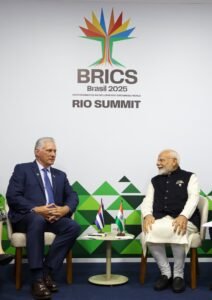New Delhi (Staff Correspondent), November 16: It is not an easy task to cover a coastline as wide as 7500 kilometres and a country that is exposed to maritime challenges from three sides. With such exposure, threats too areamplified, specially in the given scenario where conflicts between nations are rising over commercial rivalries, trade, energy security, and geopolitics.
If we talk of India, our concerns from our waterbodies are not restricted to terrorism, smuggling of arms, drugs and humans, attacks by foreign countries or encroachment on our territorial waters. In fact, in today’s world, what matters the most to a country as crucially located as India, is trade and commerce.
The Indo-Pacific region has the highest trade route in the world and therefore it becomes the responsibility of India to secure this region and safeguard merchant ships and vessels that circumnavigate this region.
But to the satisfaction of all, the Indian Navy dominates the region and ensures a multi-layered safety shield around all friendly ships and vessel that move in this region.
Other than terrorism and crime, piracy, that primarily originates from the Gulf of Aden and threatens the Western Indian coast, also poses a serious threat to India’s maritime security. To be specific, from the Sundarbans Delta region between West Bengal and Bangladesh to the Palk Strait between Tamil Nadu and Sri Lanka, these are some of the notorious stretches where trafficking, smuggling of banned goods, illicit arms, and human trafficking becomes an unending challenge.
It is with such rising threats that the Indian Navy is adequately equipped with modern ships, submarines, and aircraft.
While the Indian Navy has two aircraft carriers, 12 destroyers, 12 frigates, 2 nuclear-powered ballistic missile submarines, 16 conventionally powered attack submarines, and 20 corvettes, it also is equipped well with weapons that marl its dominance in its territorial waters. The Indian naval ships are lanced with guns like the A-190(E) 100mm, 100mm AK-100 naval gun, and AK-76/62 76mm gun. Auxiliary guns include the AK-630 6-barreled 30mm Gatling gun, and AK-230 twin 30mm gun.
Other than the aircraft and weapons, what makes the Indian Navy standout among its peers in the Indian Ocean region, are its highly sophisticated and technologically advanced fleet of submarines. The Indian Navy’s submarines are technologically advanced and have state-of-the-art weapons, navigational systems, and computer controlled machinery with a high standard of habitability.
The navy’s new communications station in Vikarabad, Telangana allows submarines to securely exchange information and receive orders from shore stations. India also has nuclear-powered ballistic missile submarines that bolster its strength in the waters.
But like they say, it is not the machines but the handler who’s skills matter. So the Indian Navy personnel undergo rigorous training in operating weapons and sensors, seamanship, look-out duties, boat-work, and man-management. They are also trained in Nuclear, Biological, Chemical Warfare, and Damage Control including Fire Fighting.
Beyond its existing infrastructure, the Indian Navy also ambitiously plans to build up to 200 vessels and 500 aircraft by 2050. This mission is being taken up at war level and India also plans to execute this plan with Atma Nirbharta, that is self reliance that the country is aiming to achieve in defence modernisation and development.
In another of its projects, the Indian Navy is building seven advanced stealth frigates to enhance the navy’s capabilities. It is also working to add Directed-energy weapons (DEWs) to its inventory, which include high powered lasers and microwaves. The DEWs are expected to destroy enemy missiles, aircraft, and unmanned aerial vehicles.
In a step towards modernisation and technological advancement, the navy is investing in advanced technologies and operating concepts for its naval aviation.
The navy’s plans include developing next-generation deck-based fighters, new maritime reconnaissance platforms, helicopters, and swarm drones for both surveillance and attack purposes.
With all the hi-tech gadgets, ammunition and weaponry in its artillery and determined to bring institutional changes when it comes to advancement of technology, the Indian Navy is said to be eighth in the world in terms of its size. The first spot is reserved by the USA that reportedly has more than 30 lakh personnel and more than 250 warships.
If the defence ministry is to be believed, the Indian Navy’s present force level comprises about 150 ships and submarines. There are presently more than 50 ships and submarines that are under construction, the ministry says. These, once ready will only boost India’s current strength and make it even stronger among its peers. Given India’s stand on international policy and its approach towards maintaining and supporting world peace it is important that India holds a position that is respected and feared of on the global pedestal.









